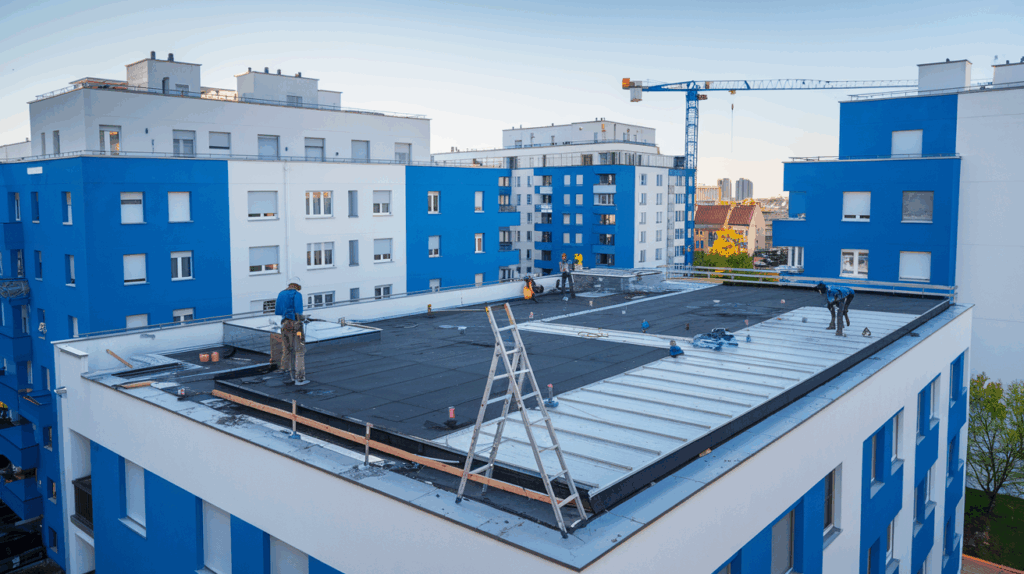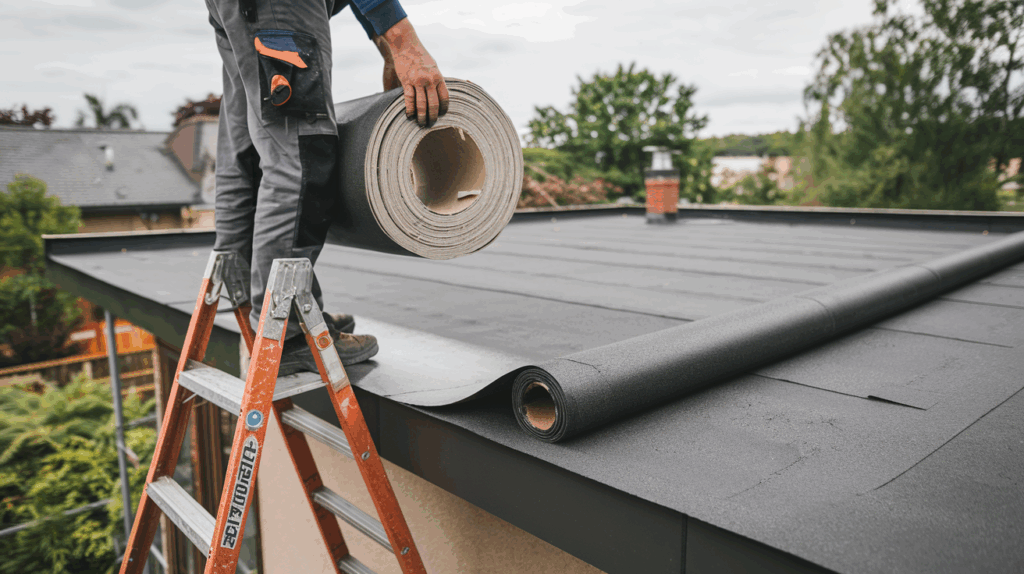Replacing a flat roof, which typically ranges from 1,000 to 2,000 square feet (9,290–18,581 sq cm), is a vital investment in protecting your home and enhancing its modern appeal.
The cost for replacement varies widely based on factors such as roofing materials, labor, location, and the complexity of the installation.
The price range typically falls between $100 and $600 per square foot. Understanding these factors will help you plan and budget effectively for this home improvement project.
In this guide, I’ll break down the key elements that influence the cost, such as material choices, labor rates, and the size of your roof, while offering tips for selecting affordable yet durable materials and contractors.
How Much Does Flat Roof Replacement Cost?
The cost of replacing a flat roof typically ranges from $100 to $600 per square foot, depending on the materials and labor involved.
For a 1,000-square-foot roof, this could mean a total cost between $10,000 and $60,000.
The price may fluctuate based on the complexity of the installation and the roofing system chosen.
While TPO or EPDM materials offer more budget-friendly options, metal roofs tend to be pricier but provide greater durability.
It’s important to consider local labor rates and any additional services, such as roof insulation or energy-efficient options, which can impact the overall cost.
Key Factors Affecting Flat Roof Replacement Costs

Flat roof replacement costs can vary widely, so I’ve outlined five key factors for a 1,000–2,000-square-foot (9,290–18,581 sq cm) roof.
These cover materials, labor, and more to keep your budget and style on point.
1. Roofing Material Choices
Materials like TPO, EPDM, or metal significantly impact costs, ranging from $100–$600/square foot. TPO offers a budget-friendly solution at $100–$200/square, while metal adds durability at a higher price.
Your choice depends on climate and aesthetic goals, ensuring a resilient, modern roof. The right material will strike a balance between cost and longevity for your home.
- TPO: Affordable at $100–$200/square, ideal for dry climates.
- EPDM: Durable rubber at $150–$250/square, great for wet areas.
- Metal: Premium at $300–$600/square, long-lasting and stylish.
2. Labor and Installation Costs
Labor for flat roof replacement typically runs $50–$100/hour, depending on complexity and region. Skilled roofers ensure a leak-free setup, especially for intricate 1,500-square-foot (13,935 sq cm) roofs with features like skylights.
Hourly rates vary by region, and complex features may increase installation time. Quality work guarantees a durable, leak-free roof.
- Hourly Rates: $50–$100/hour based on regional labor markets.
- Complex Features: Skylights or vents increase installation time.
- Quality Work: Pros ensure water-tight seals and longevity.
3. Roof Size and Complexity
Larger roofs, like 2,000 square feet (18,581 sq cm), cost more than smaller 1,000-square-foot (9,290 sq cm) ones due to material and labor needs.
A complex roof design with features such as drains or parapets will increase the overall costs, while simple layouts are more affordable.
- Square Footage: Larger roofs increase material costs.
- Complex Designs: Drains or parapets add labor time.
- Simple Layouts: Flat, open roofs reduce overall expenses.
4. Maintenance and Repair Needs
Future maintenance affects long-term costs, with TPO requiring less upkeep than EPDM. Regular cleaning ($200–$500/year) can extend the life of a 1,000-square-foot (9,290 sq cm) roof, saving on costly repairs.
Low-maintenance options can save you money in the long term. Keep in mind the material choice to avoid excessive upkeep costs.
- Low Upkeep: TPO needs minimal cleaning, saving costs.
- Regular Checks: Annual maintenance prevents major repairs.
- Material Choice: Durable options reduce long-term expenses.
5. Regional Cost Variations
Costs vary by location, with urban areas charging $200–$600/square foot compared to rural areas charging $100–$300/square foot for a 1,500-square-foot (13,935 sq cm) roof.
Regional labor and material availability affect these differences, so it’s important to compare local prices for an accurate budget.
- Urban Rates: Higher labor costs in cities increase prices.
- Rural Savings: Lower rates in rural areas reduce costs.
- Local Quotes: Compare regional prices for accurate budgeting.
Budgeting Tips for Flat Roof Replacement
Your flat roof deserves a cost-effective, stylish replacement, so follow these tips to manage expenses and quality. These ideas ensure a durable, appealing roof.
1. Get Multiple Quotes
Request quotes from at least three roofers to compare prices for your 1,000-square-foot (9,290 square centimeters) roof.
Gathering multiple quotes helps you find competitive pricing and quality options, ensuring you stay within budget.
- Compare Rates: Three quotes uncover cost-saving options.
- Check Credentials: Ensure roofers have experience with flat roofs.
- Detailed Estimates: Include materials and labor for clarity.
2. Choose Cost-Effective Materials
Opt for budget-friendly materials like TPO ($100–$200/square) instead of pricier metal ($300–$600/square).
TPO offers durability without breaking the bank.
- TPO Savings: Affordable material with strong performance.
- EPDM Balance: Mid-range cost with good durability.
- Avoid Overpaying: Skip premium materials unless necessary.
3. Plan for Maintenance Costs
Budget for $200–$500/year in cleaning and inspections. Regular maintenance will help your roof last longer and reduce the need for expensive repairs.
- Annual Cleaning: $200–$500 prevents debris buildup.
- Inspection Costs: Regular checks catch issues early.
- Long-Term Savings: Upkeep reduces major repair expenses.
4. Factor in Energy Efficiency
Consider energy-efficient materials, such as reflective TPO, to cut cooling costs. Adding insulation can further boost energy savings, keeping your home comfortable and reducing utility bills.
- Reflective TPO: Reduces heat absorption for savings.
- Insulation Boost: R-30 improves energy efficiency.
- Eco-Friendly Appeal: Sustainable materials enhance style.
Practical Tips for Managing Flat Roof Replacement
You deserve a flat roof that’s affordable and durable, so I’m sharing tips to manage costs and quality for your 1,000–2,000-square-foot (9,290–18,581 sq cm) roof. These strategies ensure a stylish, long-lasting replacement.
- Assess Roof Condition: Inspect your roof to determine if repairs are sufficient or if full replacement is necessary. This helps avoid unnecessary expenses.
- Hire Experienced Roofers: Choose roofers with expertise in flat roofs to ensure a quality installation and prevent future issues.
- Time the Replacement Wisely: Schedule your replacement during off-peak seasons for cost savings and efficient work.
- Consider Financing Options: See payment plans or loans to ease the financial burden and make the replacement more affordable.
- Review Warranty Options: Select roofing materials with strong warranties to protect your investment and save on future repairs
Conclusion
Replacing a flat roof is a significant investment, but with the right planning, it can be both affordable and durable.
I’ve found that understanding the key factors – like material choices, labor costs, and roof size – can help you make informed decisions while staying within budget.
By comparing quotes, selecting cost-effective materials like TPO, and planning for maintenance, you can ensure your roof lasts longer and performs well.
Don’t forget to factor in energy efficiency, as it can save you money in the long run.
With a bit of research and careful consideration, your flat roof replacement can enhance your home’s value and protect it for years to come.
Frequently Asked Questions
Are There Ways to Save on Flat Roof Replacement?
Getting multiple quotes and choosing TPO for a 1,000-square-foot (9,290 sq cm) roof to save on materials and labor.
How Long Does a Flat Roof Replacement Take?
Replacing a 1,500-square-foot (13,935 sq cm) flat roof takes 2–5 days, depending on complexity and weather conditions.
Do Warranties Impact Flat Roof Costs?
Yes, materials with 20–30-year warranties, like TPO or metal, add value to your 1,000-square-foot (9,290 sq cm) roof, reducing repair costs.

